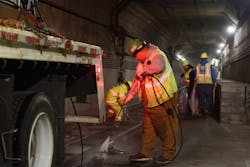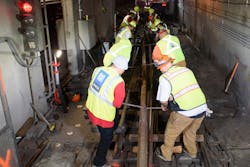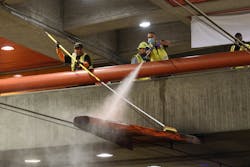SFMTA’s Fix It Week shows agency’s commitment to infrastructure upkeep
One of the challenges rail transit operators face is finding the balance between performing critical work to maintain rail infrastructure while not inconveniencing riders with lengthy service delays and changes. A maintenance initiative developed by San Francisco Municipal Transportation Agency (SFMTA) finds harmony in its approach to fixing its aging infrastructure to deliver more reliable service without burdening its riders with lengthy delays and impacts to service.
In 2019, the agency launched Fix It Week, where service was limited during a period of seven to 10 days to focus on completing many projects at once. SFMTA explains the idea driving Fix It Week is to take advantage of periods of reduced ridership, as opposed to continually starting and stopping service as repairs come up.
The region of San Francisco, Calif., heavily relies on transit to get from place to place. Fix It Week has mainly targeted SFMTA’s Market Street subway, which was built in 1975 and contains several original components. Every night after Market Street subway service hours, SFMTA maintenance crews work to maintain the tracks and equipment underground, however, the team only has approximately two hours to get the work done, which SFMTA says is insufficient to accomplish meaningful maintenance work. During extended Fix It Week work windows, maintenance crews from various specialties work simultaneously, which increases the effectiveness of their efforts.
“Fix It Week allows us to bring teams from multiple shifts and force multiply the number of teams and the number of projects,” said SFMTA Chief Maintenance Officer Charles Drane. “During a typical week, we may have 28 hours of closure time. During Fix It Week, we will double that up to about 56 hours, but you'll see anywhere from 2,000 to 2,500 employee hours of maintenance done in the tunnel during that time.”
Drane notes most of the infrastructure work done during Fix It Week is work riders don’t see, including replacing batteries and overhead contact wire, along with expanded inspections, track work, fastener replacements, tie replacements and structural inspections on the tunnel.
Drane meets with the nine Maintenance of Way (MOW) Teams (Track, Cable Car, Motive Power, Maintenance Engineering, Mechanical Systems, Overhead Lines, Underground, Paint Shop and Signal) that are involved in the maintenance work regularly, including custodial staff cleaning SFMTA stations. The meetings determine which areas the teams will attack during Fix It Week.
“We always have a constant revolving list of priorities to tackle when we're on a Fix It Week that we want to target,” Drane said. “Is the lighting good? Are the elevators operating well? We take everything into account and we fold that into some of those critical items that we go to target.”
SFMTA strategically schedules its Fix It Weeks throughout the calendar year. The agency tries to schedule the week around holidays or three-day weekends but there are a variety of factors in the scheduling, including sporting events and other activities. With the use of public transit being so high in the San Francisco area, SFMTA will adjust Fix It Week service hours if there is an event where public transportation is needed. The agency attempts to conduct a Fix It Week once a quarter but with the pace of events in the area, it has not materialized to that level yet.
“The weeks are never identical,” Drane said. “We try to give ourselves about two months notice when we find a space in the calendar but we really are a partner to the community and try not to disrupt some of the civic activity that's happening in San Francisco.”
Drane notes Fix It Week days do not have to be consecutive, especially with sporting events with the city’s professional teams happening almost year-round.
“If the Warriors are playing or we have a certain event with the Giants, we might have to do five days and then leave the service available for the Giants for people to finish up the baseball game and get home to commute to and from and then continue another five days,” Drane said.
Drane stressed the Fix It Week service interruptions are not service shutdowns, but that they are early system closures, noting that instead of a closing time of 12:30 a.m., service may stop three hours earlier at 9:30 p.m. as an example. The agency also provides shuttles in replacement of some of the rail service hours during Fix It Week.
With Fix It Week affecting service hours over a longer period than a traditional service delay, SFMTA makes sure the community is aware long in advance before each Fix It Week takes place so residents have time to make transportation plans.
“We not only inform the media about Fix It Week, but we inform the public as well,” said Steven Chun, SFMTA deputy spokesperson. “We do a lot of messaging in advance on social media, as well as signs in the tunnel and around the station.”
The agency conducted two Fix It Week’s in 2019 before the March 2020 COVID-19 pandemic public health emergency was declared in the U.S., causing Fix It Week to be suspended until it was restarted in 2022. SFMTA has now conducted a total of seven Fix It Week’s. The results have been overall positive, with SFMTA reducing major delays in the Market Street subway by more than 70 percent since the launch of Fix It Week.
The seventh Fix It Week occurred over the Martin Luther King Jr. holiday (Jan. 15) in the U.S. The agency viewed the week as successful, as it continued infrastructure work on the Market Street subway.
Drane says Fix It Week can be used as a training course for the nine MOW Teams. He states he uses Fix It Week as a “springboard [for] manager and supervisor training,” while pointing out everybody has a role during Fix It Week. Said roles change every Fix It Week, giving employers opportunities to be versatile in their managing experience overseeing various projects at a time.
Drane acknowledged Fix It Week would not be a success without support from not just the teams that do the work, but the entire SFMTA.
“Success does not happen without everybody involved at the agency,” Drane explained. “It’s our security enforcement teams, our station agents assisting us with kind of opening the stations, closing the stations, passing out information because it can be a little confusing. It can be different because we're closing early, having our transit management center and how they control and help us get everything closed up. It's an entire agency effort through communicating, through support, through coordination. The maintenance teams are planning and doing the maintenance but the broader agency is helping us with so much support.”
The next Fix It Week is scheduled to take place between March 8 and March 16, 2024. The focus will continue to be on the Market Street subway. SFMTA is hoping to reach its goal of completing at least one Fix It Week every quarter during 2024.
Typical Fix It Week By the Numbers:
- 56 hours- Fix It Week closure time
- Nine Maintenance Teams
- 2,000 – 2,500 hours- Maintenance and inspections completed during Fix It Week
About the Author
Brandon Lewis
Associate Editor
Brandon Lewis is a recent graduate of Kent State University with a bachelor’s degree in journalism. Lewis is a former freelance editorial assistant at Vehicle Service Pros in Endeavor Business Media’s Vehicle Repair Group. Lewis brings his knowledge of web managing, copyediting and SEO practices to Mass Transit Magazine as an associate editor. He is also a co-host of the Infrastructure Technology Podcast.





